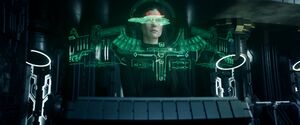Romulan Free State
More actions
- You may also be looking for the Romulan Republic or the Star Empire of Rator.
The Romulan Free State was formed in the aftermath of the Romulan supernova that destroyed Romulus and Remus. Of the many successor states that arose with the collapse of the Old Romulan Star Empire, the Free State is the largest and most powerful, and presents itself as the most viable leadership for the future of the Romulan people.
With the backing of the Tal Shiar and occupation of some of the old empire’s most resource-rich territories, the Free State has established its own interstellar relations, entering into treaties and agreements with other Alpha and Beta Quadrant governments to become legitimised as a major power. This was buoyed up by their possession of the Artifact a damaged Borg Cube whose study was the subject of a research agreement with the Federation.
The Free State suffered a significant blow to its prestige in mid-2399 after events at the planet Coppelius. There they lost the Artifact, mobilised their fleets against a Starfleet task force only to be routed, and soon after the news became public of the Tal Shiar’s involvement in the Attack on Mars. However, with the fall of the Star Empire of Rator in 2400, the Free State gained vast stretches of new territory, and is now undisputed as the most significant Romulan government. As such, despite these tensions, the Federation has no choice but to treat with the Free State.
History
Establishment (2387-2393)
Following the destruction of Romulus and Remus in 2387, the Empire split into multiple factions of various sizes and volumes of power. The Romulan Star Empire relocated to Rator III, led by the Praetor and largely supported by the Romulan Star Navy.
Many leaders of the reformed Star Empire were senators or officials of the old government, and viewed by many as having failed to respond to the crisis quickly enough. Their continued leadership was opposed by a series of regional rulers in what were once the core systems of the old Empire, the most resource-rich and politically powerful beyond Romulus itself. With the fallen empire’s territories in chaos, they anticipated their riches and wealth would be redirected to shore up weaker regions in whose safety they had no interest.
This discontented and powerful faction was soon supported by the Tal Shiar, which for reasons of its own chose to not back the reforming Star Empire. The Free State was thus empowered to establish its own centre of government on T’Met, one of the earliest Romulan colonies beyond the Romulus system, with their own Senate and Praetor. Laying claim to many of these formerly core sectors, they presented themselves as a true future for the Romulan people, not one led by those they deemed responsible for the catastrophes of the supernova.
Over the previous decade, the Tal Shiar navy had managed to rebuild to its pre-Dominion War levels, giving the Free State a fighting force unparalleled by any except the Star Navy itself. With the Star Empire scrabbling to bring more disparate factions to heel, it could not afford a direct confrontation with the Free State’s military, despite refusing to recognise the legitimacy of its government. This gave the Free State several years to establish governance and border protection, while it continued to expand into territories the Star Empire claimed as theirs.
Legitimacy (2393-2399)
In 2393, the government of the Achernar System formally swore allegiance to the Free State, enraging the Star Empire. A task group of Star Navy ships was dispatched to bring Achernar to the fold, only to be met by the Free State’s forces. What followed was the largest battle between Romulan forces to date, in which the Star Navy was routed at the cost of significant Free State military losses.
The Free State recognised their authority stemmed from stability and the perception they could provide a safer and more secure way of life than other, more chaotic factions. Further weakening of their forces was untenable. A treaty was thus offered to the Star Empire, in which the Free State agreed to fix their borders - which now included Achernar - within the old imperial territories, and expand no further. In true Romulan fashion, this was a double-edged sword of an agreement, where the Free State’s abandonment of further claims stymied them as an ongoing threat to the Star Empire for the price of formal acknowledgement by their rivals.
The Romulan Star Empire was struggling on multiple borders, including that of the Romulan Republic, leaving them eager to turn away from the Free State. Starfleet Intelligence further suspects meddling at Rator by the Tal Shiar. The Romulan Star Empire’s acceptance of the treaty was carefully-worded, suggesting they viewed the Free State as a satellite to their own rulership, but in practice accepting their rule of these territories and no longer condemning them as upstart rebels.

Now the legitimate rulers of some of the most powerful regions of the old empire, the Free State continued to establish itself as a major power. Negotiations with the Federation over access and sharing research on the Artifact accelerated. While cooperation had continued these past years, the Federation had been apprehensive of overly-favouring the Free State, but its possession of the Artifact was now complete.
The following six years were a time of growth and prosperity for the Free State. Large and powerful, it drew interstellar legitimacy by entering agreements such as the renegotiated Treaty of Algeron and became recognised as a major Beta Quadrant power on a par with the Star Empire. Unlike the Star Empire, it kept its borders fixed and did not weaken itself trying to regain control of former imperial territories or expand into the chaotic Neutral Zone, restricting its activities in the region to neutralising threats of criminals, warlords, or unstable systems.
Coppelius (2399)

In mid-2399, the Romulan Free State deployed a fleet to Coppelius in the Ghulion system, home to a colony of synthetic life-forms. Dispatched to eliminate the synths, the Free State forces were soon confronted by a Starfleet Task Force that arrived in response to a request for aid and protection by Coppelius. Official reports state that the Free State peacefully withdrew once informed of Coppelius’s status as a protectorate under the Treaty of Algeron, but this near-conflict remains a point of tension between both governments. At the same time, the Free State lost control of the Borg cube, which departed its location in their territory and ultimately crashed on Coppelius itself. The loss of the research agreements surrounding the Artifact has been a major blow to Free State interstellar prestige. Worst of all, soon after came the emergence of the Tal Shiar’s involvement in the Attack on Mars. For the past twelve years, the Free State has cited its Tal Shiar support as a point of its legitimacy, and thus their insistence that it cannot be held responsible for actions undertaken before its government’s establishment has fallen on deaf ears within the Federation. Relations thus cooled greatly.
The Fall of Rator (2400)
Much to the good fortune of the Free State, 2400 heralded the end of their biggest rival, the Star Empire of Rator. A military coup on Rator led to the secession of many worlds under the Star Empire's authority, and the Free State was quick to exploit it. While significant stretches of territory ran to the Free State for protection and governance, the Tal Shiar was quick to influence others to either follow suit or, at the least, abandon Rator.
Through barely lifting a finger, the Free State has found itself the foremost Romulan government. It gained more than territory from Rator's fall, but also legitimacy. The Federation now has little choice but to acknowledge and work with the Free State to maintain security in a chaotic region, and can no longer support its rivals to keep it in-check, with the distant Republic successful but little threat to the Free State's dominance. After a false start at the dawn of the 25th century, the Free State is set to become the true successor to the old Star Empire.
Government
Replicating the Old Romulan Star Empire structure of a republic senate, the Free State has largely the same working and government arrangements of its predecessor, choosing to improve old failings while keeping a familiar structure. The Free State has set T’Met as its homeworld, which is overseen by a Praetor whom the Senate selects. Both Praetor and Senators serve until retirement or death. Much smaller than the old Empire, the Free State was able to establish itself quickly, as many of its senators and leaders were part of the regional governments of powerful core systems who remained intact after the supernova.
The Senate has direct control of all navy vessels, however these are Tal Shiar assets and the Senate control is more ceremonial than operational, with the Tal Shiar having a large controlling influence on the Senate.
Within the Star Empire, the Senate operated with a Continuing Committee. The Free State has elected to not implement this into their government, seeing it as an unnecessary and lengthy process to governing, with some within the Free State seeing the Continuing Committee as one of the reasons so many were lost during the evacuation of Romulus. Instead, the Free State has invited the heads of the major departments within the State to sit in Senate meetings with no voting rights. The only two departments to actually take up the offer of a seat is the Free Science Initiative and the Tal Shiar.
Tal Shiar

The Tal Shiar, coequally referenced as the Tal'Shiar and Tal Shi'ar, is closely intertwined with the Free State government, though it is in certain ways a governing body unto itself. It is led by the Tal Shiar High Command, which operates with a freedom enjoyed by no other body of the Free State. It selects its own members without outside input, with the sole exception of the Vice Chairman’s position, filled by a Romulan Senator. In practice, this grants the Tal Shiar both a voting representative in the Senate and an additional voice with the organisation’s personal seat, buoying up their formal power.
The two main divisions of the Tal Shiar are those of Intelligence and Internal Security, which formally answer to the High Command - though, in practice, the High Command monitors bureaucracy and budgetary concerns to ensure their efficiency. The Intelligence Division is the Empire's primary agency for espionage and counterintelligence and covert influence abroad, a task at which it is extremely effective. Internal Security controls the secret police, who have made the Tal Shiar infamous with the Romulan populace. They ensure the loyalty of the populace to the Free State, as they once did for the Empire, though under the new government have adopted a more discreet network of informants among the populace to identify dissident individuals or political and cultural thought. Unlike in the Empire of old, a select faction of dissidents and opponents of the Free State are permitted to act and speak openly, curated as progressive voices which are not too extremist and thus give the Free State a veneer of respectability and even democratisation while any true threats are eliminated.
The oldest and most powerful division is the Tal Shiar Court, which is the Free State’s supreme judicial authority. Previously serving the role within the old Star Empire, its presence in the Free State provides the new government with some of its greatest claims to legitimacy, allowing it to present itself as the judicial heir to the old empire. The Court's members are recommended by the Praetor, and must be confirmed by the Senate and the Court itself. All matters of constitutional law and final legal appeals depend on the decisions of the Court. The Tal Shiar Court operates independently from - and is often at odds with - the more infamous Tal Shiar divisions of Intelligence and Internal Security.
Tal Shiar Navy
The naval forces of the Free State are the military wing of the Tal Shiar that gave the government their support upon its founding. Where once this organisation acted in close cooperation with the old Star Navy, its ships serving alongside theirs to provide a Tal Shiar presence, the Tal Shiar Navy is now its own, independent military. Many aspects of its structure and operational policies have been incorporated from the Star Navy, which better suit a force answering the strategic needs of a state.

Considering the Free State’s size, the Tal Shiar Navy is one of the smallest armed services of the quadrant, prioritising advanced technology on modern ships over numbers. With the force historically overseeing the Star Navy and conducting intelligence operations, the Tal Shiar Navy was not expected to be deployed in direct confrontations. This assumption was corrected in the Achernar Campaign of 2393, where the Tal Shiar Navy defeated the Star Navy as they contested rulership of the system. Despite heavy losses suffered by the Tal Shiar Navy, its efficient chain of command and sophisticated technology allowed it to dominate its erstwhile rival.
With border protection largely conducted by outposts, surveillance facilities, and light border patrol craft, the Tal Shiar Navy is more likely to act as a rapid response force to any crises in the Free State than hold major garrison points across the territories. However, as befits the armed wing of the greatest intelligence organisation in the galaxy, the mystery surrounding naval operations and movements makes them extremely hard to predict, and opportunists test the Free State’s defences at their peril.
Life in the Free State
The Free State tries to present itself as the future of the Romulan people. While it has no interest in liberal reform or further democratisation, and is in many respects a deeply traditional institution, it has endeavoured to distance itself from the mistakes of the old Romulan Star Empire it claims allowed the deaths of so many millions of Romulans in the supernova.
The Free State territories are largely former core worlds which historically enjoyed a high standard of living and a respectable place within imperial society. These have only grown in prestige with the loss of Romulus itself, allowing these worlds to depict themselves as the new heart of Romulan culture. Thus there exists some eagerness among the Romulans of the Free State to develop new art, new philosophies, and forge a forward-looking society. All of this is underpinned by attitudes which remain traditional, the rich and powerful of the old trying to create something new that still upholds extant systems of power.
There are almost no Remans within the Free State. Loyalists largely remained with the Star Empire of Rator, while others departed the core worlds with the Romulan Republic. Small pockets or military units with personal loyalties may live and serve in the Free State, but they are an even more diminished faction under this government than ever before.
Life in the Free State is thus not all that different to how life was on these worlds under the Empire. The Tal Shiar’s influence is supreme, with dissident thought permitted only so far as it allows the government to test ideas it then repackages and reincorporates to let it present itself as a force for modernisation. Doing away with old forms of the Senate’s bureaucracy has in many ways removed old checks and balances that, while imperfect, distributed power across the empire.
At worst, the Free State is a traditionalist Romulan culture with delusions of modernity and reform that only reinforce conservative values. At best, citizens of the Free State view the Romulan attitude of secrecy and information as necessary for their safety, but also as a responsibility, where they must safeguard each other’s secrets and act in the interests of a Romulan future, rather than an individual’s personal benefit.
In Play
- The Free State is a leaner, meaner version of the Romulan government of old. Supported by the Tal Shiar, it holds the richest worlds of the empire and boasts the most advanced ships, without struggling to retain its hold over expansive territories. At its best, it is all of the cut-throat ruthlessness of the Romulans, with none of the decadent inefficiency.
- Almost everything in the Free State is under the Tal Shiar’s influence, from the government to the military. While they pretend to be more forward-thinking than before, this is largely shadowplay to disguise their presence. The Free State is more of a surveillance state than even the Star Empire. Little happens without the Tal Shiar’s knowledge.
- It has a vested interest in maintaining stability in the Neutral Zone and the wild region of disparate factions of the old Star Empire on its border. As such, it will sometimes dispatch agents or forces to eliminate warlords, criminals, or other groups they do not wish to become too powerful on their front door. These are the most common circumstances for Starfleet encounters with the Free State: military or Tal Shiar assets beyond the borders of both parties, open to events being denied or disavowed. Use this as a chance for some small, tense encounters which are not politically destabilising if they go badly.
- Star Trek: Picard has implied the Free State to be the largest and most significant Romulan government, and Bravo Fleet canon has developed along those lines. However, the Intelligence Office considers it possible it will receive attention and development in future seasons of Picard. As such, while the Free State is now the 'default' Romulan faction, relations with the Federation remain cool. Storylines will not significantly advance or develop until further screen canon arrives, and writers are advised to keep their stories, as above, to encounters beyond the Free State's borders.
